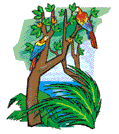Food Webs: Who Eats Who
An overview of the levels of a food chain/web, energy transfer from level to level, and the complexity of these interactions.
Objectives:
• Students will distinguish between producers and consumers.
• Students will recognize the sun as the source of energy for producers.
• Students will become familiar with the vocabulary associated with food chains.
• Students will understand the loss of energy that occurs as energy flows from one level to the next.
• Students will recognize the complexity of the relationships in a food web.
Suggested Grades:
5th Grade - 6th Grade - 7th Grade
Print the reading comprehension passage and questions (see below).
Students should read the passage silently, then answer the questions. Teachers may also use the text as part of a classroom lesson plan.
Lesson Excerpt:
If you spent some time in a forest watching the animals that live there, you would realize that one of their main activities is finding food. All organisms, including people, need energy to live. Organisms that must eat to live, like people, are called consumers or heterotrophs. Organisms that can use the sun's energy to make their own food are called producers or autotrophs. Plants, some algae, and certain kinds of bacteria are producers. They directly or indirectly provide the energy for all of the organisms in the ecosystem. Producers must do their job in order for consumers to eat and live.
All life depends on energy from the sun. Plants can use this energy, through the process of photosynthesis, to make the sugar they need to live and grow. Animals then eat plants or eat other animals to get the energy they need.
Continued...

Lesson Printables:
Print this printable worksheet for this lesson:


